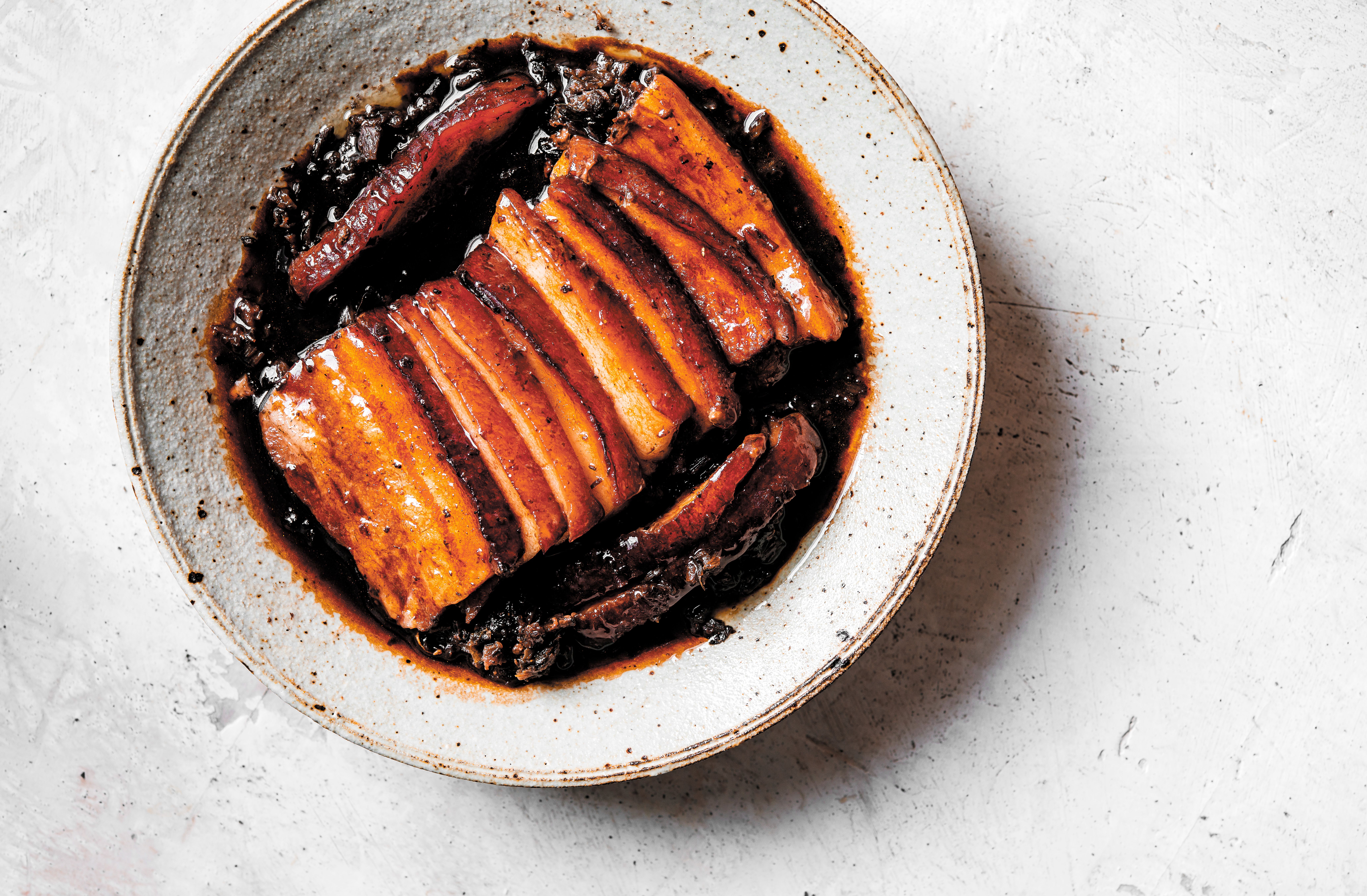Sun-Dried and Preserved Greens With Steamed Pork Belly recipe | Epicurious.com
Your folders
Your folders
Servings: 4
Author : Betty Liu

Ingredients
Export 11 ingredients for grocery delivery
Instructions
Preparation Finely chop the mei gan cai. You should have about 3 cups of fermented mustard greens. Set aside. Place the pork belly in a large pot and add enough water to cover. Crush the slices of ginger and the scallion segments with the flat slide of a cleaver to release the aromatics. Add the sliced ginger, scallions, star anise, and bay leaves to the pot and bring the water to a boil. Boil for 5 minutes, flip the pork belly over, then boil for another 5 minutes. Remove the pork to a shallow plate with tongs and let cool, reserving the water in the pot. Pour a pool of dark soy sauce in the shallow plate. Dip all sides of the pork belly into the soy sauce to darken it. Use a chopstick or toothpick to poke holes into the skin. Dip all sides of the pork belly in the soy sauce again. Place the pork, skin side down, in the soy sauce and let sit for 10 minutes. Remove the pork belly from the soy sauce and place it skin side down on a wire rack over a baking sheet; let it air-dry for 10 minutes. Flip the pork belly and place it skin side up on the rack; let it air-dry for another 10 minutes. Meanwhile, mix together the remaining 1 tablespoon of dark soy sauce, the light soy sauce, rock sugar, and wine in a mixing cup. Heat a well-seasoned wok over low, then add enough oil to cover the skin of the pork (about 3 tablespoons). Place the pork belly skin side down in the hot oil and immediately cover the wok with a lid to contain the oil splatter. Cook for 6 to 8 minutes, until the skin is crackled. Briefly fry the other sides of the pork belly until golden. Transfer to the pot with the reserved warm water and let soak for about 20 minutes, until the rind is soft and plump. Reserve the oil in the wok. When cool enough to handle, slice the pork into ¼-inch (6-mm) slices. Place the slices in a heatproof bowl, skin down, and fan the slices out slightly. Pour in half of the soy sauce mix. Set the wok with reserved oil over medium-high, stir-fry the minced ginger in the reserved oil until aromatic. Add the mei gan cai and stir-fry. Pour in the other half of the soy sauce mix, then stir-fry to incorporate the sauce. Turn off the heat. Spread the mei gan cai mixture in a generous layer over the pork belly, making sure the pork is covered completely, and place in a bamboo steamer or steamer basket. Steam, covered, over 2 inches (5 cm) of water on high for 20 minutes, then reduce the heat to medium-low and steam for another 60 minutes. Gently pour out the excess liquid in the bowl by tipping it into a small saucepan. Place a plate or a large shallow bowl on top of the bowl in the steamer, then carefully flip the bowl so the pork belly sits on the plate, skin side up, on a bed of fermented greens. Sprinkle with the remaining chopped scallion. Bring the reserved liquid to a boil and reduce into a thick sauce. Slowly stream in the cornstarch slurry as needed to thicken the sauce. Spoon the sauce over the pork belly and serve with rice. About the mei gan cai Mei gan cai are greens (which can be mustard greens, amaranth, or even napa cabbage) that have been salted, dried, and then fermented, creating a funky, tangy dish that pairs well with pork. This is a quick and inexpensive way to add a punch of flavor to any dish. When buying dried mei gan cai, try to find a package that specifically states “Shaoxing.” The darker the mei gan cai, the longer and headier the ferment, and the better the flavor. The amount of soy sauce used can vary depending on the potency of the fermented greens. Rinse the mei gan cai very thoroughly to remove dirt— an overnight soak followed by 5 to 6 rinses will do it. Rinse until there is no debris left in the water. You can make this dish ahead of time—letting it sit overnight in the fridge will only improve the flavor. Simply steam it again to reheat before serving. Reprinted with permission from My Shanghai: Recipes and Stories from a City on the Water by Betty Liu, copyright © 2021 by Betty Liu. Published by Harper Design, an imprint of HarperCollins Publishers.Buy the full book from Harper Collins, Amazon, or Bookshop.